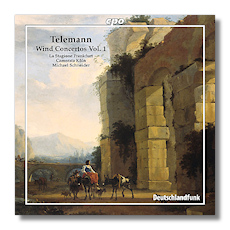
The Internet's Premier Classical Music Source
Related Links
- Telemann Reviews
- Latest Reviews
- More Reviews
-
By Composer
-
Collections
DVD & Blu-ray
Books
Concert Reviews
Articles/Interviews
Software
Audio
Search Amazon
Recommended Links
Site News
 CD Review
CD Review
Georg Philipp Telemann

Wind Concertos, Volume 1
- Concerto in D Major for 2 horns, Strings & Continuo, TWV 52:D2
- Concerto in E minor for Recorder, Transverse Flute, Strings & Continuo, TWV 52:e1
- Concerto in D minor for Oboe, Strings & Continuo, TWV 51:d1
- Concerto da camera in G minor for Recorder, 2 Violins & Continuo, TWV 43:g3 *
- Concerto in E Major for Transverse Flute, Strings & Continuo, TWV 51:E1
La Stagione Frankfurt/Michael Schneider
* Camerata Köln
CPO 777032-2 DDD 55:24
This disc is the first volume in a projected series of Telemann's wind concertos. This should keep the performers quite busy if they plan to record all of them. The composer's mastery of many instruments and many national styles placed him in an excellent position to produce a large and varied corpus of concertos for wind instruments. Unlike Bach, who tended to be something of a stay-at-home (he was a family man, after all!), Telemann was a traveler. His high standards assisted him in making most if not all of his wind concertos a joy to hear.
Telemann's range is displayed on this CD. In addition to the variety provided by the different instruments used, there is great stylistic variety as well. One of Telemann's most delightful works is the Concerto in E minor for recorder, transverse flute, strings, and basso continuo – probably one of the composer's later works. First, the idea of combining the recorder and the flute was a happy one. (However, the booklet note points out that during Telemann's time, the instruments probably were closer in timbre than they are today.) The concerto's final movement, marked Presto, is unmistakably a country dance, given the bagpipe effects in the bass. These probably were suggested by Polish music, with which Telemann was familiar.
Telemann also was cognizant of Italian and French styles, and the latter are displayed in the Concerto da camera in G minor. In some ways, it is closer to a suite, because the opening movement is followed by a Siciliana, a Bouré (an alternative spelling of Bourrée), and a Menuet. This particular work is interesting also because it has some of the characteristics of a sonata, and some of the characteristics of a concerto. In the words of cpo's annotator, "As seems to be the case, Telemann, the great master of eclectic combination, took special delight in such hybrid forms." That's true for much of the music on this CD.
La Stagione Frankfurt, conducted by Michael Schneider, and Camerata Köln seem to "take special delight" in Telemann's music. The playing of all, including the soloists, is stylish, full-blooded, and quite virtuosic. For example, the two hornists, Ulrich Hübner and Jörg Schulteß, laugh away the difficulties of the D-major concerto. Similarly, conductor Schneider (doubling on recorder) and flutist Karl Kaiser produce melting tones in the odd-numbered movements of E-minor concerto, and great brilliance in the even-numbered movements. (Schneider also plays a prominent role in the Concerto da camera.) Oboist Luise Baumgartl's contribution to the Concerto in D minor also brings great pleasure. Tempos are justly chosen throughout, and the precision of the playing is very high. Add to this the excellence of cpo's engineering, and you have a CD that should stimulate both relative newcomers to Telemann's music and Telemann's loyal admirers.
Copyright © 2008 by Raymond Tuttle




















